Author: Marshall Schott
Mashing is a necessary step for all-grain brewers that involves steeping milled grain in warm water with the purpose of allowing the starch in the malt to be enzymatically converted to sugar, namely maltose, thereby producing sweet wort. Ask any typical brewer how long this process takes and the most common response will undoubtedly be the same: an hour. Interestingly, most of these brewers have likely also heard (or read) somewhere at sometime someone with some semblance of authority on the subject say that most conversion occurs within the first 15 minutes or so of this saccharification rest, a notion Kai Troester was able to demonstrably support in his 2009 experiment. And yet, perhaps out of fear or just plain inflexibility, my timer still gets set for 60 minutes every time I close my mash tun.
I recently read an inspirational brewing philosophy by a dude I’ve admired, Denny Conn, co-author of the upcoming book Experimental Homebrewing (pre-orders available): Make the best beer possible while having the most fun possible while doing the least work possible. Amen, brother Denny! As much as I enjoy the brewing process, I have this obsession with reducing the time and effort it takes while maintaining a quality finished product, something a reduced mash step would certainly contribute to.
| PURPOSE |
To investigate the differences between 2 beers mashed for different lengths of time. Two separate 5 gallon batches of wort were produced using the same grain bill, one mashed for 30 minutes and the other 60.
| METHOD |
I needed to make an Oktoberfest for an upcoming club competition and, given my adoration for this style, figured it’d be a good one for such an exBEERiment. Rather than type it out, the recipe can be found in the recipes sections of this site. Since these were both 5 gallon batches, I decided this would be a simple no sparge brew day and filled each kettle with the full volume of brewing liquor for each batch.
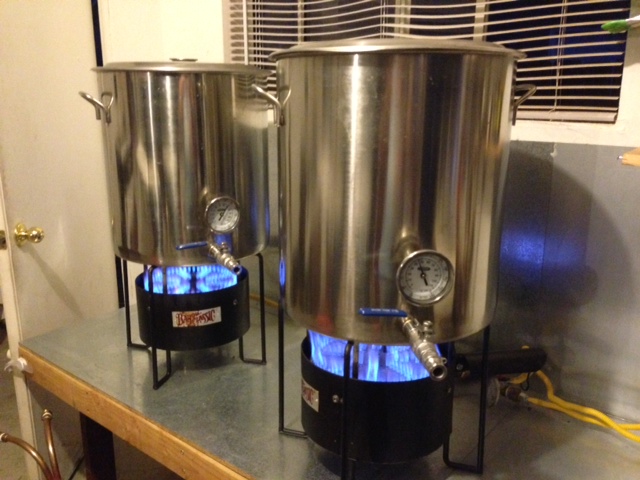
While I usually stagger my double-batch brew day mash-ins by about 30 minutes, I started the long-mash only about 5 minutes after closing the lid on the short-mash MLT. My target mash temp for this batch was 151°F.
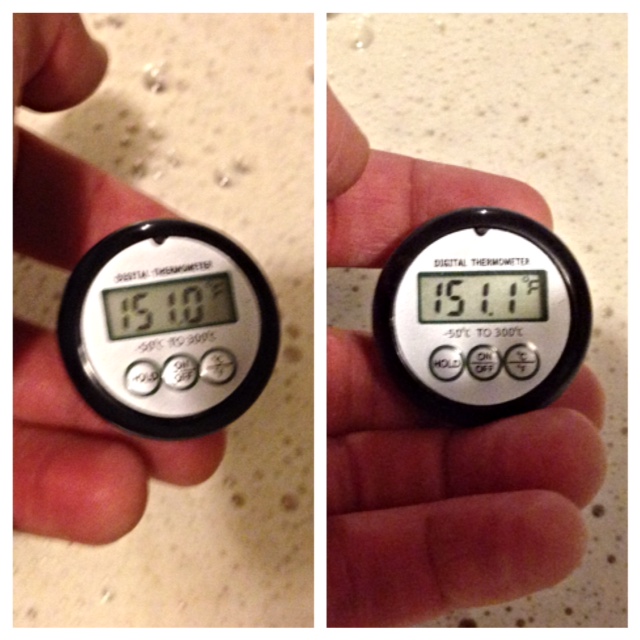
I stirred the short-mash twice during the 30 minute rest then ran off the sweet wort. Roscoe always enjoys turning the valves and watching the bucket fill.
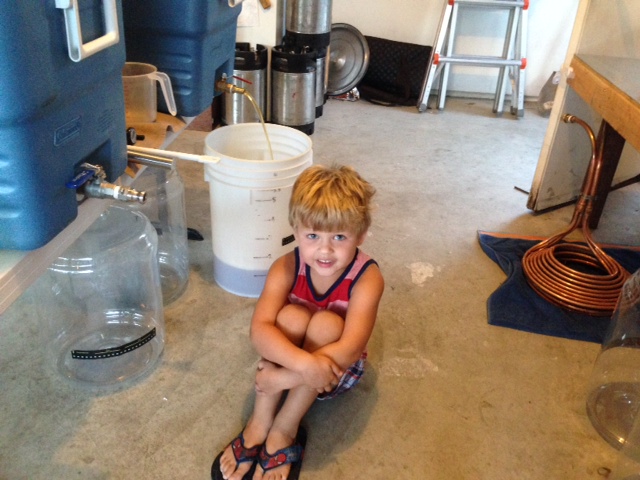
It was amazing how quick that felt! The short-mash was boiling by the time I began running off the sweet wort from the long-mash.

While the pre-boil gravity was exactly the same for both batches, there appeared to be just a tiny difference in post-boil SG, nothing really significant.
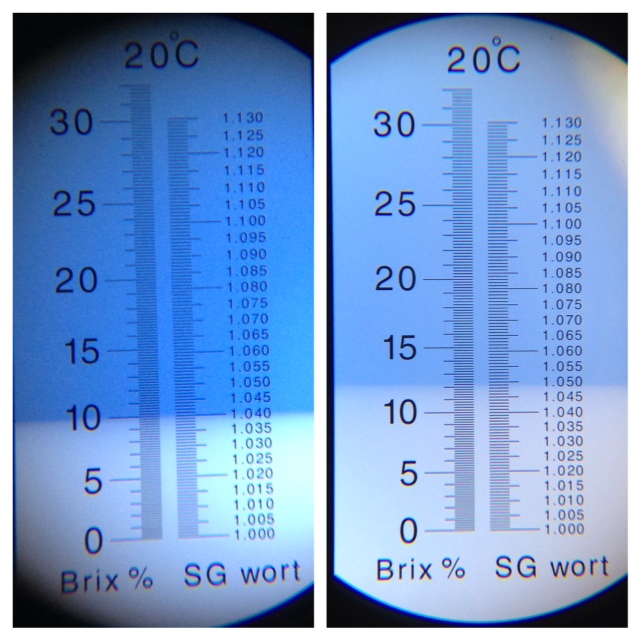

Each batch was chilled to about 80°F (groundwater was 75°F) using my King Cobra IC, racked to labelled carboys, and placed in the cool fermentation freezer to finish chilling to my target pitching temp of 56°F. Once reached, WLP029 starters were pitched and the hybrid fermentation profile I created in The Black Box was engaged. I noticed some action about 12 hours later.
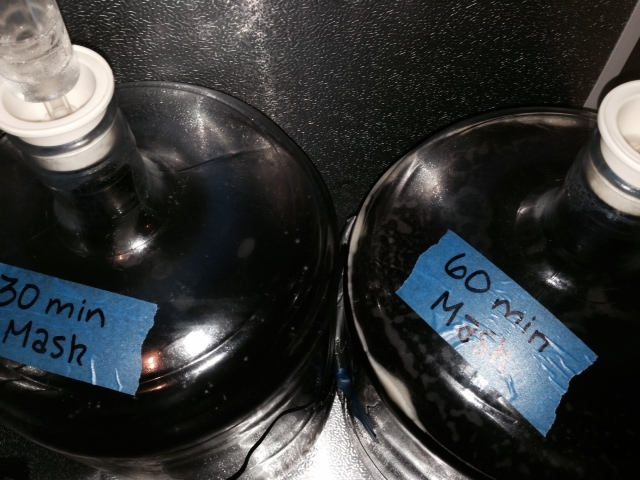
Things were looking very similar at 24 hours post-pitch.

A couple days later and things were still about the same.

It wasn’t until about a week after pitching the yeast that things started to appear to be a little different with the krausen on the short-mash beer seeming to drop before the long-mash beer.
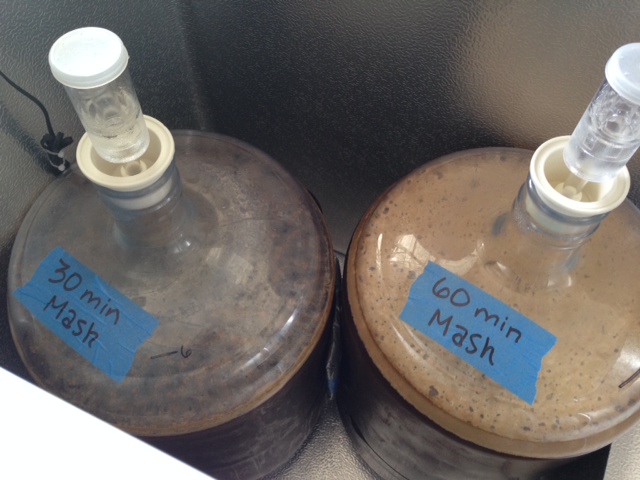
I thought it only prudent to measure the SG at this point, assuming the fallen krausen indicated a potential stall, but they were at the same spot.
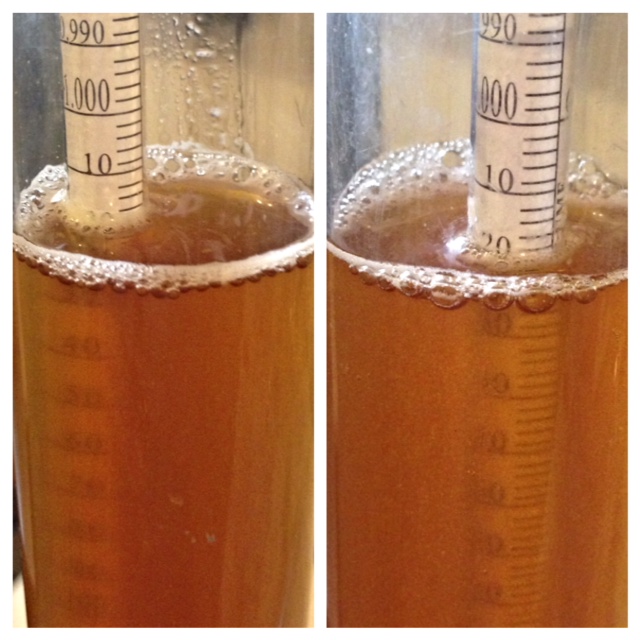
After a few more days at 68°F, fermentation activity had come to a visible halt, so I took hydrometer sample a couple days apart and both beers were right at 1.015, .002 higher than expected, but I was satisfied and proceeded to packaging per my standard kegging method.
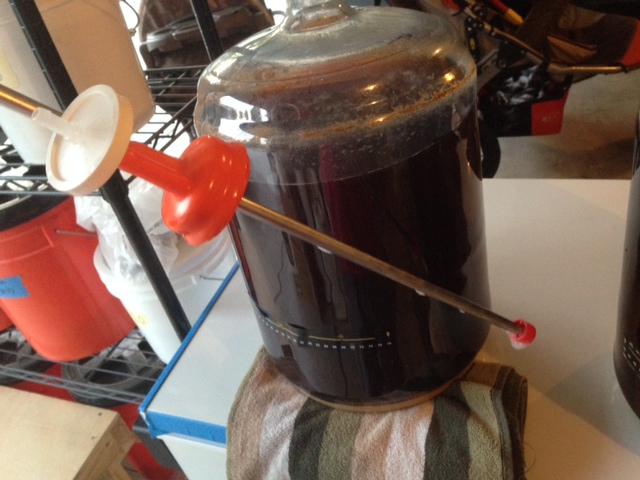
After about 10 days in the 38°F keezer, the beers were carbonated and ready for evaluation.

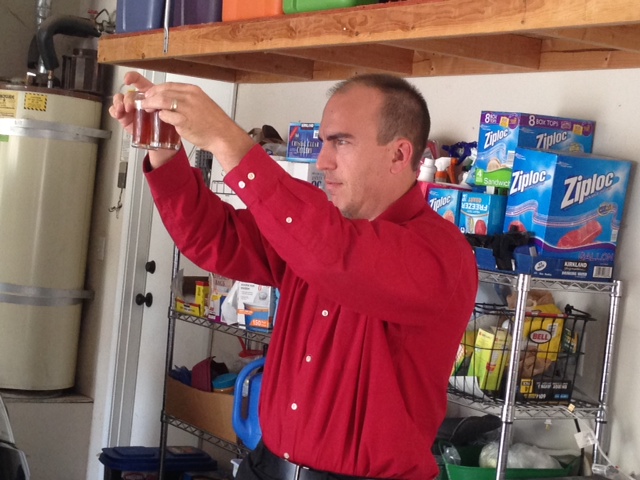
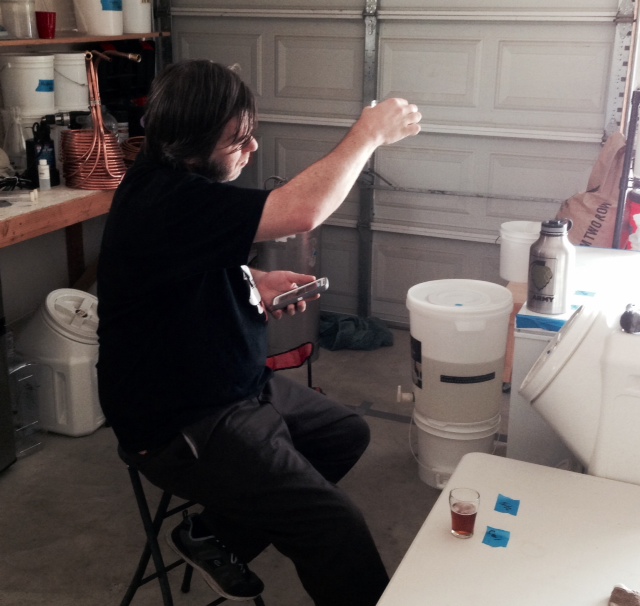
| RESULTS |
For the purposes of keeping the beers anonymous, they were each assigned a name. In this case, the long-mash was called Fritz and the short-mash was called Carl.
Appearance
– 50% observed Fritz to be clearer than Carl, 40% found no difference in clarity, and 1 person thought Carl was clearer
– 80% found no difference in color (darkness) and 20% thought Fritz was darker
– 60% said Carl had better head retention and 40% noticed no difference
– 60% thought the general appearance of the beers was exactly the same, while the remaining 40% said they were somewhat similar
– Overall, 60% found no difference in appearance, 30% thought Carl looked better, and 10% thought Fritz looked better
Aroma
– 50% thought Fritz had more malt aroma, 30% thought Carl was more aromatically malty, and 20% found no difference
– 80% perceived no difference in hop aroma, 10% thought Fritz had a stronger hop nose, and 10% thought Carl was more hoppy smelling
– 50% perceived no difference in ester/phenol aroma, 30% thought Fritz had more esters/phenols, and 20% thought Carl had a stronger ester/phenol aroma
– 50% found no difference in terms of off/unpleasant aromas, 40% thought Fritz had more off-aromas, and 10% thought Carl smelled less pleasant
– 70% reported the general aroma of the beers to be somewhat similar, 20% said they were exactly the same, and 10% perceived no similarities in aroma
– Overall, 50% thought Carl had better aroma, 30% perceived no difference, and 20% thought Fritz smelled better
Flavor
– 60% perceived Fritz as having more malt flavor, 30% found no difference, and 10% experienced Carl more malty
– 70% perceived no difference in hop flavor, 20% thought Fritz had more hop flavored, and 10% thought Carl was more hoppy tasting.
– 56% thought Fritz had more yeast/fermentation caused flavors, 22% thought Carl had a more unpleasant yeast character, and 22% perceived no difference
– 50% found no difference in off-flavors, 30% thought Carl had more off-flavors, and 20% thought Fritz was more off-tasting
– 80% reported the general flavor of the beers to be somewhat similar, 10% said they were exactly the same, and 10% thought they were not at all similar
– Overall, 50% thought Fritz had better flavor, 30% thought Carl tasted better, and 20% noticed no difference
Mouthfeeel
– 50% thought Fritz had more body, 30% chose Carl as being fuller bodied, and 20% experience no difference
– 50% perceived no difference in carbonation, 30% thought Carl was better carbonated, and 20% reported the carbonation in Fritz was better
– 70% found no difference in tannin character, 20% thought Carl was more tannic, and 10% said Fritz was more tannic
– Overall, 44% preferred the mouthfeel of Fritz, 33% thought Carl felt better on the tongue, and 22% perceived no difference
In terms of overall preference, 50% of the tasters reported they preferred Fritz, 40% preferred Carl, and the remaining 10% (a single participant) thought they were too similar to determine a preference.
After answering all of the questions blindly, the tasters were informed of the nature of this exBEERiment and asked to guess which of the beers they thought was mashed for 30 minutes. 50% accurately guessed Carl, 30% incorrectly guessed Fritz, and 20% thought they were too similar to tell a difference. For fun, I also ask the participants to guess what they think the nature of the exBEERiment is, prior to revealing it, and only if they feel comfortable doing so. For the first time, it appears one of the panel members, Daniel White, was correct, typing, “possibly mash time?” Nice job, Daniel!
My Impressions: I’ve had these beers on tap now for a couple weeks and have done my best to compare them as objectively as possible. While I really wanted the short-mash beer (Carl) to come out ahead or at least taste the same as the long-mash beer (Fritz), my honest opinion is that I perceived Fritz as having more of the characteristics I expect in a good Oktoberfest– it had more toasty/Munich malt charcter, slightly more body, and I just enjoyed it more than the other beer. After this exBEERiment, I have no plans to change my normal mashing routine, though I do think it would be good to redo this on lighter and darker beers.
| DISCUSSION |
While 10 people may limit generalizability, I would contend it was at least a relatively representative sample and that the results would like remain in a similar range given increased participants. As has been the case in a couple past exBEERiments, it would appear there is little in the way of differences between a beer, at least this particular Märzen, mashed for 30 minutes compared to the same beer receiving the more typical 60 minute mash treatment. My hunch, which is admittedly just a fucking hunch, is that some of differences perceived by participants can be attributed to the expectation of difference between the 2 sample beers rather than actual differences.
As a result of the apparent lack of significant differences, I would definitely recommend others who are looking to shorten up their brew day a bit consider cutting their mash time in half, despite my own decision to continue mashing for an hour. While I attempted to restrict other variables as much as possible, there’s a chance the differences I experienced, if they indeed existed, were caused by something other than the length of the mash. I’ve heard from a number of homebrewers, in fact, who mash between 15 and 30 minutes regularly and swear their beers come out just as great as when they mashed longer.
If you have any questions, comments, or recommendations, please don’t hesitate to share. Cheers!
Support Brülosophy In Style!
All designs are available in various colors and sizes on Amazon!
Follow Brülosophy on:
FACEBOOK | TWITTER | INSTAGRAM
| Read More |
18 Ideas to Help Simplify Your Brew Day
7 Considerations for Making Better Homebrew
List of completed exBEERiments
How-to: Harvest yeast from starters
How-to: Make a lager in less than a month
| Good Deals |
Brand New 5 gallon ball lock kegs discounted to $75 at Adventures in Homebrewing
ThermoWorks Super-Fast Pocket Thermometer On Sale for $19 – $10 discount
Sale and Clearance Items at MoreBeer.com
If you enjoy this stuff and feel compelled to support Brulosophy.com, please check out the Support Us page for details on how you can very easily do so. Thanks!











47 thoughts on “exBEERiment | Impact Reduced Mash Length Has On A Märzen”
Great work, Marshall, and very interesting results. A bit contrary to my own beliefs, but I’m in no way knocking your results. It would have been interesting to have seen a blind triangle on the beers, but you’ve certainly provided food for thought.
I started off with a triangle test, which I certainly see the value in, but that became really difficult with tasting groups of 3+ people, particularly trying to integrate it into the TypeForm survey. I’m definitely open to any ideas!
I enjoyed your article and experiment, however I would consider over 2 Brix difference in the beers to be pretty significant. The additional 30 minute mash time obviously converted more starches. You could calculate your mash efficiency from the short rest then increase your grain bill to compensate. My concern would be starch haze from all of the unconverted grain. Cheers!
Hey man, thanks! Where’d you get 2 brix different?! That is significant, but these beers were .001 SG different prior to pitch and finished at the same SG. Unless there’s a typo I missed…
Looks like he didn’t read the captions on your refractometer picture.
Yep, sorry apparently I suffer from the inability to read captions correctly. Or perhaps I should stop day drinking. Well done.
I did the same thing too, assuming at first that the side by side photos were the two batches side by side for comparison.
I’ve regularly done 30-40 minute mashes using Maris Otter and American Pale Malt making IPA’s and pale ales with good success. I’ve hit all my numbers and won some awards. Nowhere near the level of control and scientific method you employed but I’d be curious what the results would be with less variables (i.e. simpler grain bill; an ale; use 1056; etc.) vs. your recipe. Just a thought. Awesome work!
Perhaps do an experiment involving two identical samples to see what the effects of the perceived difference might be to people anticipating an experiment?
😉
I’d be interested to see if the differences became greater at higher gravities.
Great article! I recently started doing 30 minute mashes (down from 60) on some of my beers and I’ve seen no real difference whatsoever. Admittedly, I’ve never done a side-by-side comparison like you did but it seems to me that the difference is negligible. The majority of my mashes are still an hour, but it’s nice to know that you can save 30 minutes if need be.
Curious what would happen in more conventional, thicker mash with a sparge. I understand why you did things the way you did way but it’s not how most people mash (or is it?)
Interesting question, for sure! I think a lot more people are doing full volume mashing, consider BIAB, though you’re probably right that it’s not how most people are doing it… yet, at least.
Do you think Maillard reactions had anything to do with the long mash beer having slightly better flavor?
I wouldn’t think that’s it, but I’ve really know way of telling. Perhaps?
Roger starts an interesting thought. Was your post boil volume identical? A slightly harder boil could give more toast and caramel – maltyness. The mash length question has been toiled with very much over the years. I always say, if You like the beer, who cares when you’re homebrewing! To see this done with 7 or 10 BBL would really be interesting! Cheers!
Post-boil volume was near identical, though I didn’t measure it using super precise tools or anything, just a dip stick.
I think you missed out on a key detail – a recipe like yours would be expected to convert very quickly as the vienna, munich and pilsner all contain sufficient enzymes to convert themselves + some adjuncts (i.e. you had a surplus of amylase working on your mash). Its of no surprise that the beer converted quickly – similar brews that I’ve done have been iodine-reaction negative in as little as 15 min.
However, conversion rates will be slower with beers using higher levels of adjuncts, as the starch:amylase ratio will be higher, meaning it will take longer (enzymes have finite reaction rates) for conversion to complete in those beer. The longest I’ve seen for conversion is 65 minutes (in a beer that was 50% adjuncts), with 30-45 min being the norm for my high-adjunct beers.
Bryan
I would like to see this done again, but for a 1 hour vs. overnight mash. I’ve read about some people mashing in the evening, starting at proper temp, then waiting until morning to sparge and start the boil. I’d be very curious to see if that makes any positive or negative difference in the beer, as it may make it a lot easier for some people to brew if they can do it in a couple of hour-and-a-half blocks rather than one 3-4 hour block.
Now that I think about it, the answer might be simple–you’re mashing at a temp where beta amalyase is likely fully denatured after 30 minutes (http://braukaiser.com/wiki/index.php?title=The_Theory_of_Mashing#Starch_conversion_enzymes).
I’d be interested to see what the difference between a 60 and a 90 minute rest would be on favor and gravity. A lot of the German beers have those low mash temps but longer rests. It would be cool to see if the longer rest really matters.
A triangle test would have been a more appropriate method for this experiment. You bring the evaluator three samples, with two of them being the same. They pick the one that they perceive to be different. With 10 people you can do this 3 times for a total of 30 test which will give you a much more statistically relevant data set. This is the most common way of sensory evaluation for a single variable. Cool experiment, cheers!
We are definitely changing things up a bit for future exBEERiments… though these were never really intended to be über scientific. I’ve returned to seeing value in the triangle test. Thanks for the comment, cheers!
Thanks for publishing your results. I’m always trying to learn more.
Wonder what the effect would be if you did a shorter mash with BIAB. It’d be cool if you could myth-bust the 90-min-mash BoogeyMan for BIABers 🙂 I’ll bet it’s BS, although having said that there are other factors that could come into play such as are they using RIMS, etc. I use a RIMS setup with an electric BIAB rig I built very similar to this one (http://www.highgravitybrew.com/store/pc/BIAB-Electric-Brewing-System-269p3987.htm) and to be honest with you with my setup I consistently get 80%+ efficiency – and that’s *including* using the steamer basket as a “colander” for the grain bag, which supposedly makes efficiency go through the floor. The system (and method) are great, but idk about 90 min….. : / With those kind of efficiencies, I’m wondering what would happen if it was dropped to 45 min.
I’ve been doing BIAB for over a year, I usually mash for about 45 minutes then start my mash out, it’s always worked really well.
Cool – I’m giving it a try then – any time i can shave off a brew day pleases SWMBO.
I’d be interested in seeing the results of a longer mash. I brew BIAB, and frequently find that I get interrupted (kids!!) and end up mashing for 2 hours or more. I think that I’m ending up with more fermentable wort overall, but I’m not sure if that’s from the long mash or from raising from protein rest to sacch rest temp with the grain in the bag and having some of it convert at a lower temperature on the way up. At the moment I tend to do the sacch rest at a slightly higher than normal temp and that seems to balance things out nicely.
Sounds like you’re proposing a long mash vs. “normal” mash length exBEERiment. I added it to the list!
I would have expected a much higher FG for the 30 minute…
http://3.bp.blogspot.com/-RlmsRKlsklI/UNx-dyTm7cI/AAAAAAAAAbE/lv336X02SQk/s1600/160+mash.PNG
Sorry! Wrong graph!
http://2.bp.blogspot.com/-mXUkFVUtv0E/UNx-YKp2gjI/AAAAAAAAAa0/KzUUb4mRn3Y/s1600/150+mash.PNG
Definitely want to see more tests on full volume mash times and temps. I’d like to see if there is something to the “thin” beer BIAB thing. This goes against what I would have thought for sure. Very nice article.
I really appreciate all of your hard work in the pursuit of homebrewing excellence and I look forward to reading more. If you ever happen to revisit this topic could you consider looking at 60 minute vs 90 minute mash times? I have had others tell me that an extended mash pushing 90 minutes results in better conversion. Also, I may have just missed it, but have you considered looking at mash thickness? I have read differing accounts on this topic. I understand that thicker mashes tend to favor proteolytic activity whereas thinner mashes tend to favor diastatic activity.
Seems that I failed to read every comment as this was brought up, at least in part, in other comments. Anyway, keep up the good work and I look forward to the next experiment!
Ha, no worries, and thanks for the support. We definitely have more mash xBmts on the including 90 min vs. 60 (and 30) min and mash thickness!
More mash length xBmts are coming!
Just to bring my little contribution to this thread, I made 20L of IPA with a Braumeister with a 60′ mash instead of my usual 90′ and it has much less body than usually, so I’ll stick to 90′.
Did you compare the 60 min and 90 min mashes side by side? If not, it stands that your memory of the 90 min mash is skewed by your knowledge of the variable and bias. Interestingly, one might actually expect less body from a longer mash.
PREEEE-CISE-A–LILLY!
While I certainly cannot absolutely say it did or did not have more body, or argue with your perception, but experience and mot literature suggests the opposite would be true, for most instances. I also double down on – not blind, not unbiased, not side-by-side.
My theory is that brewers have historically mashed and boiled their beers for longer periods because longer mashing means more time hanging out and drinking with brew buddies.
Of course, one could always reduce the mash time and just brew twice the amount of beer…
Try this one on…
In the book by Greg Koch, et all called “The Craft of Stone Brewing Co.”, the last chapter has several recipes for their beers. In several of them, it calls for a mash time of 10-30 minutes. Stone Pale Ale for example calls for a mash temp of 156 for 20 minutes. Stone Levitation calls for a mash temp of 157 for 10 minutes! This is written by Greg Koch(supposedly), and the rest of the recipe for each do make sense. Yet I am completely perplexed by this one element. I have never heard of mash times this short. Comments?
As cool as I am with shorter mash lengths, one thing to consider when comparing huge commercial operations to homebrewing is the actual time it takes to lauter. Stone is a continuous sparge brewery and hence they collect their wort relatively slowly, and when they do the grains are immediately “rinsed” with warm sparge water. On the other hand, when I batch sparge, it takes me maybe 8-10 minutes to collect all of my sweet wort. Does it matter? I’m not sure, but one thing I’ve accepted is that homebrewing practices, while fundamentally similar, are qualitatively different than commercial practices as a function of scale.
In the book, the recipes and process are designed for the homebrewer, so that is a given. These aren’t commercial processes they are giving. They describe a lautering and continuous sparge with temp of water not to exceed 170 until the mash tun is completely drained. I still don’t see how there could be full conversion in 15-20 minutes, much less 10(Levitation).
Interesting. 10 minutes certainly seems like very little. Hmm.
Marshall – any thought to redoing this exBEERiment now that you’re using the triangle test and a greater number of tasters? All of your taster’s thoughts/comments/preferences (including your own ;^) are moot if they can’t pick the odd beer out in a blind triangle test.
Recently I’ve read about a overnight mash. I think if it works well is a very good way to shorten the brew day. I will try it in my next beer.
It’s on the list?
Cheers!!